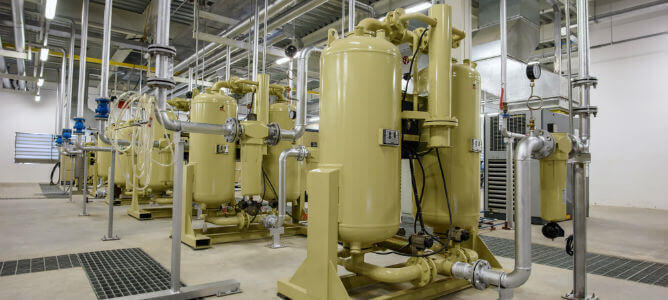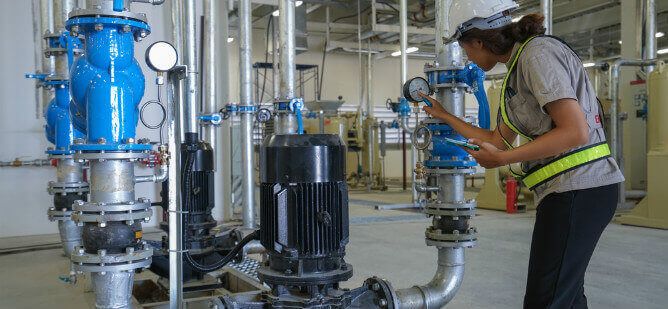
Air Compressor Installation 101: A Step-by-Step Guide
Installing an industrial air compressor is a tedious task that demands precision and expertise. Whether you’re setting up a new facility or upgrading your existing system, understanding the fundamentals of air compressor installation is a must.
Read this guide, where the air compressor experts at NiGen explore the many aspects of the installation process — ensuring optimal performance, efficiency, and safety.
How to Install an Industrial Air Compressor
Proper air compressor installation is important to ensure the longevity of your equipment. In this step-by-step guide, we’ll walk you through installing your new industrial air compressor.
Step 1: Choose the Right Location
The first step in installing an air compressor is selecting the correct placement. Consider factors such as noise levels, ventilation, accessibility, and proximity to electrical outlets. You’ll want to choose a well-ventilated area with enough space for the compressor and easy access for air compressor repairs and maintenance.
Step 2: Prepare the Foundation
Before installing the air compressor, ensure that the foundation is level, stable, and capable of supporting the weight of the equipment. A concrete pad or a sturdy floor is ideal for this purpose. If necessary, use shims or leveling tools to achieve a stable base.
Neglecting proper foundation preparation can result in adverse consequences: increased vibrations and noise, misalignment issues, reduced air compressor lifespan, safety hazards for personnel, higher maintenance costs, and overall degradation in compressor performance.
Step 3: Connect the Power Supply
Next, connect the air compressor to a suitable power supply. Follow the manufacturer’s instructions and local electrical codes to ensure proper wiring and grounding. Use a dedicated circuit with the correct voltage and amperage rating to avoid overloading the electrical system.
Step 4: Install the Air Intake Filter
Proper air filtration is crucial for the longevity and efficiency of your air compressor. Install an air intake filter to prevent dust, debris, and contaminants from entering the compressor. Ensure that the filter is easily accessible for regular cleaning or replacement.
Failing to properly install the air intake filter can lead to severe consequences. Without proper filtration, airborne contaminants such as dust and debris may enter the compressor, causing increased wear on internal components, reduced efficiency, potential damage to the compressor elements, and compromised air quality in downstream applications.
Step 5: Set Up the Pressure Regulator and Safety Valve
The next step is to install a pressure regulator and safety valve to control and protect the air compressor. The pressure regulator allows you to adjust the desired pressure output, while the safety valve releases excess pressure to prevent damage or accidents. Follow the manufacturer’s instructions to install these air compressor components correctly.
Step 6: Connect the Air Outlet
To use the compressed air, connect an air hose or piping system to the compressor’s outlet. Use high-quality fittings and connectors that are compatible with your specific air tool requirements. Ensure that all connections are tightened securely to prevent air leaks.
Improperly connecting an air hose or piping system to the compressor’s outlet can be detrimental. Air leaks may occur, leading to reduced system efficiency, increased energy consumption, and potential damage to the air compressor due to overheating. Insufficient connections can compromise the overall integrity of the compressed air system, impacting downstream applications and potentially causing safety hazards.
Step 7: Test and Adjust
Once everything is set up, it’s time to test the air compressor. Turn on the power and allow the compressor to build up pressure. Check for any unusual noises, vibrations, or leaks. Adjust the pressure regulator as needed to achieve the desired output. Learn more about air compressor testing.
Step 8: Regular Maintenance
To keep your air compressor running smoothly, perform regular maintenance tasks such as checking and replacing filters, draining condensate from the tank, and lubricating moving parts. Refer to the manufacturer’s guidelines for specific air compressor maintenance instructions and intervals.
REMEMBER: Proper air compressor installation and air compressor audits are essential for the safe and efficient operation of your system. Always consult the manufacturer’s instructions and seek professional assistance if needed. Following these steps, you can enjoy the benefits of a reliable air supply for your various projects and applications.
Get Started with NiGen’s Industrial Air Compressors
With NiGen’s high-quality, reliable, and efficient air compressors, you can optimize your productivity and achieve exceptional performance. Whether you need compressed air for manufacturing, construction, or any other industrial application, our compressors deliver the power and reliability you need. Don’t miss out on this opportunity to improve your operations.
Get in touch with our team to learn more about the various types of air compressors we have available for purchase and rent — or if you have more questions about air compressor installation!


